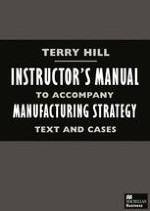2000 | Buch | 2. Auflage
Über dieses Buch
In this fully revised and updated edition of his successful text, Manufacturing Strategy Terry Hill shows that a strategic approach to manufacturing management is essential for the survival and prosperity of industrial companies. He has formulated an approach which will help companies to develop an understanding of the implications of the corporate marketing and finance decisions for their manufacturing processes and infrastructures.
Instructor's Manual available.
Anzeige
